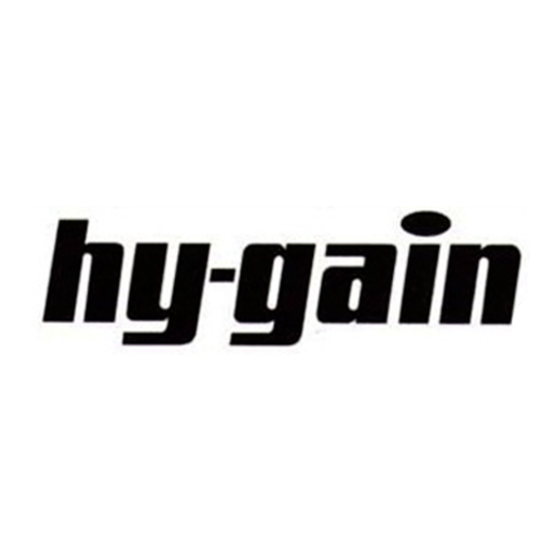
Advertisement
~in
,{J,I}
~
~~/~cc,_/
•.• ASE STATION BI-L1NEA'R AMPLIFIER
The Bi-LinearAmplifier
advanced design. It util izes an integrated circu it, two tubes, two
transistors and three diodes and a grounded grid, tuned plate
circuit for amplification
of AM, FM, CW/and SSB signals
The Bi-Li near Ampl ifier will operate over the frequency range
25-54 MHz. However, it is F.C.C. Type Accepted under Parts 89,
91, and 93 over the frequency range 25-40 MHz.
Operation of this equipment requires a FCC license. Failure to
comply
is punishable by penalities set forth
Regulations of the FCC. A copy of these Rules is available from
the U.S. Government
Printing
possessionof the operator.
The 482 Bi-LinearAmplifier
shipped from the factory, and must be used with a transceiver
which is FCC Type Accepted under Parts 89, 91, and 93 for the
~stem
to be valid.
A specia' 'eature of the Ampl ifier
change over relay
which
connections making it perfect for operation with
transceivers not having external ampl ifier control circu its.
Another feature is that this unit amplifies the received signal, uti-
lizing an integrated circuit
Variable plate tune and load capacitors offer impedance matching
for maximum output to varying antenna loads in the 40-70 ohm
range.
The Bi-Li near Ampl ifier has been designed and constructed to
suppress radiation that may cause television interference. TVI
problem has been given full consideration in design and layout of
the chassis.
There are, however, some types of TV I that cannot be prevented
within the amplifier. This is particularly true in weak signal areas.
In such cases, a good commercial low passfilter is recommended.
MECHANICAL SPECIFICATIONS:
'~'ight
~'~vlfidth
Depth
Net Weight
Shipping Weight
Construction
ORDER NO.
482
.u·,-",
115
VAC
is a precision built, compact amplifier of
in the Rules and
Office
and should be in the
complies with FCC Regulation when
is the automatic
operates without
special external
amplifier.
Lightweight aluminum chassis
with rugged steel case
INSTALLATION
OPERATION
HY-GAIN
Rural Route 3
Power Requ irement
Frequency Range
Types of Emmission
Power Output (Slightly lessat 50 MHz)
Amplification
Drive Requirement to Trigger AntEmna Relay
Max Drive (unmodulated carrier and FM)
(amplitude modulated carrier)
(amplitude
Harmonic Supression
Input Impedance (unbalanced)
Output Impedance(unbalanced)
Antenna Switching
Tube and Diode Complement
Cable Connector Data
antenna
*F .C.C. Type Accepted for frequency range 25-40 MHz only
low power
()
Carefully remove the amplifier from the packing carton. Ex-
amine it closely for signs of shipping damage. Check to insure
tubes are seated in the sockets.
tubes.
Inspect for any signs of internal damage.
Do not attempt to operate your amplifier until you have read
the manual and properly installed the unit.
() The location is not critical but consideration must be given to
adequate ventilation.
()
IMPORTANT:
the cabinet for good air circulation.
() The primary power connection on the amplifier is a standard
115 V AC line plug.
() The fuse holder is provided on the rear panel with a 3 amp, 3
AG
fuse.
Do
transformer, and power supply will not be protected.
() The unit should be operated with a good ground. Water pipes
4 1/8"
and other house fixtures are not recommended.
7 1/8"
() The Bi-Linear Amplifier
10 3/8"
systems designed for the 25-54 MHz* range provided the antenna
11 Lbs.
has a resistive input impedance between 40-70 ohms. The SWR
12 Lbs.
should be kept to a minimum of 2: 1 or less.
() The output connector provided is an SO-239. For connection
of your antenna, you will need a PL-259 plug.
&
INSTRUCTIONS
ELECTRONICS
Lincoln, Nebraska 68505
AM, FM, CW, SSB, DSB
80 Watts CW (with 3.5 watts drive)
of Received Signal",
modulated peak)
'.. suppressed more than 60db
nominal, less than 2: 1 VSWR 25-54
nominal, Adjustable 40-70 ohms, nonreactive
.:
Automatic provided by RF
"2 Transistors, 3 Diodes
Check the plate caps on the
Allow at least 4" of clearance on all sides of
not
use a larger capacity
will work with the common antenna
CORPORATION
115 V AC
3Amp
25-54 MHz*
220 Watts PEP, SSB,
or DSB
20 db
1 Watt
:
15 Watts
,3.5 watts
14 watts PEP
50 Ohms
MHi*
50 Ohms
sensing network
2 Tubes
1 Integrated Circuit
Input and Output
require MIL PL-259
fuse or amplifier,
Advertisement
Table of Contents

Summary of Contents for Hy-Gain 482
- Page 1 MHi* possessionof the operator. Output Impedance(unbalanced) 50 Ohms nominal, Adjustable 40-70 ohms, nonreactive The 482 Bi-LinearAmplifier complies with FCC Regulation when Antenna Switching Automatic provided by RF shipped from the factory, and must be used with a transceiver sensing network...
- Page 2 Also seen on output meter. JUSTMENTS MUST BE MADE ONLY BY A FCC LICENSED TECHNICIAN. The 482 Bi-LinearAmplifier is factory adjusted for the range 25-32 MHz. Operation over the range 32-40 MHz requires a change in the number of turns in L 1 (RF Tank Coil). A shorting...
- Page 3 240 pF SM C2, 29, 30, 2200 ..••.••. F 1KV Disc Ceramic R7, 13 33.n. 1/4W Resistor 8, 28, 20 150 .•...•• F 1KV Disc Ceramic 2200ft 1/4W Resistor 56.••...•. F 1KV Di sc Ceramic 1W Resistor 10ft 50 ..•.• uF 1KV Disc Ceramic RFC1, Ohmite Z-144 Choke...
- Page 5 Place the function switch in the SSB position, apply drive power, and adjust the tune and load controls for maximum output. The delay circuit for SSB prevents "drop-out" of the automatic antenna relay between characters. Remove knobs and replace controls cover before putting the Amplifier into busi ness radio service ..
- Page 6 This warranty does not extend to any units which have been repaired or altered outside of our factory nor to cases where the serial number has been removed, defaced or changed. The manufacturer guarantees to remedy for a period of 90 days All labor, tubes, semi-conductors and other...


Need help?
Do you have a question about the 482 and is the answer not in the manual?
Questions and answers